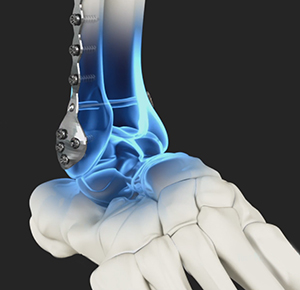
What is Ankle Stabilization?
Ankle stabilization refers to treatments and techniques aimed at strengthening the ankle joint, preventing excessive movement, and reducing the risk of sprains or instability. This can include physical therapy, bracing, and surgical procedures to repair or reconstruct damaged ligaments, ensuring better balance, support, and long-term joint health.
Symptoms of Ankle Instability
Common signs that you may need ankle stabilization include:
- A persistent feeling of ankle weakness or instability
- The ankle frequently rolling or turning, particularly while walking or playing sports
- Pain, tenderness, and swelling in the ankle joint
Causes of Ankle Instability
Chronic ankle instability typically develops from:
- Repeated ankle sprains, which weaken the ligaments over time
- Incomplete healing after a sprain, leading to long-term instability
- Insufficient rehabilitation, which prevents full recovery and strength restoration
Ankle Stabilization Surgery
When non-surgical treatments such as bracing, physical therapy, and activity modifications fail to restore ankle stability, surgical intervention may be necessary. Ankle stabilization surgery repairs or reconstructs the damaged ligaments, providing long-term strength and mobility.
Types of Ankle Stabilization Surgery
- Anatomic Repair – Shortens and tightens stretched ligaments to restore stability.
- Non-Anatomic Repair (Tendon Graft Reconstruction) – Uses a tendon graft (from the patient or a donor) to replace severely damaged ligaments.
Who is a Candidate for Ankle Stabilization Surgery?
Surgery is recommended for individuals with:
- Chronic ankle instability despite conservative treatments
- Severe ligament damage that prevents normal ankle function
- Frequent ankle sprains affecting mobility and daily activities
Anatomic repair is preferred for most cases, while non-anatomic repair is used when the existing ligaments are too damaged or when additional support is required (e.g., for overweight patients).
How is Ankle Stabilization Surgery Performed?
Anatomic Repair Procedure:
- Performed under epidural anesthesia
- A small incision is made to access the damaged ligaments
- The torn ligament is shortened and reinforced with sutures
- The extensor retinaculum (a strong connective tissue band) may be used for additional support
- The incision is closed, and a sterile bandage is applied
Non-Anatomic Repair (Tendon Graft Reconstruction):
- Performed under epidural anesthesia
- A donor tendon or the patient’s peroneus brevis tendon is used
- Drill holes are made in the fibula and talus to attach the new ligament
- The tendon graft is woven through the bone for strong reinforcement
- The incision is closed, and a sterile bandage is applied
Recovery and Rehabilitation
Post-surgery, immobilization is crucial for healing:
- A cast or splint is worn initially to protect the repair
- Crutches help avoid weight-bearing for the first few weeks
- A removable boot is used for 2-4 weeks after splint removal
- Physical therapy is introduced to restore strength and mobility
- Full recovery typically takes 10-12 weeks
Benefits and Considerations of Ankle Stabilization Surgery
Advantages of Anatomic Repair:
- Uses the body’s own ligaments for a natural repair
- Preserves joint mobility
- Faster recovery with minimal complications
- Smaller incision for reduced scarring
Considerations:
- May require revision surgery if ligaments loosen over time
Advantages of Non-Anatomic Repair:
- Provides greater strength for severely damaged ligaments
- Ideal for patients needing extra stability (e.g., those who are obese)
Considerations:
- Reduces rear foot motion
- Removes peroneus brevis tendon, which plays a role in ankle stability
Potential Risks of Ankle Stabilization Surgery
As with any surgery, there are possible risks, including:
- Nerve injury leading to numbness or tingling
- Chronic pain or stiffness
- Rare need for revision surgery

